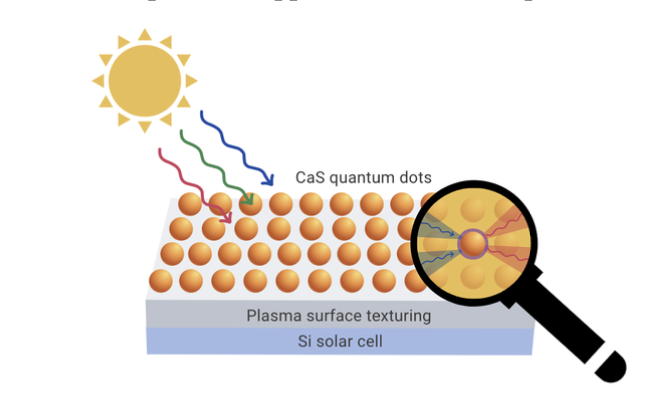Hydrothermally Synthesized CaS Quantum Dots as a Luminescent Downshifting Layer on Solar Cells

- Alysa Corinne T. Llantero, Alexander P. Cristobal, Shekinah Sheena B. Sahagun
- Philippine Science High School Main Campus, Philippines
Abstract
Despite the advantages and widespread use of solar cells, typical solar cells exhibit poor spectral response at shorter wavelengths, resulting in a maximum efficiency of 31%. The application of semiconducting nanocrystals, otherwise known as quantum dots (QDs), has recently shown significant potential in producing highly efficient solar cells due to their small size and unique absorption characteristics. QDs are semiconducting nanoparticles with a regular crystal structure, measuring less than 10 nanometers in diameter. One of their applications is as a luminescent downshifting (LDS) layer, which has been found to improve the conversion efficiency of solar cells. Despite this, most QD-based solar cells as of date employ QDs made with heavy metals, such as Cd and Pb. While effective, a major drawback of these compounds is their high toxicity and harmfulness to the environment. Because of this, there has been a demand for more environment-friendly and non-toxic QD alternatives, otherwise known as green dots. Calcium sulfide (CaS) quantum dots are green alternative semiconductor nanoparticles that have been shown to shift to shorter wavelengths after confinement, making it a theoretically favorable material for photovoltaic application. Despite this, no known studies have been conducted that apply CaS QDs in solar cells and evaluate their effectiveness in improving solar cell performance. Thus, this study evaluates the effectiveness of hydrothermally synthesized CaS QDs as an LDS layer on commercial silicon (Si) solar cells. The CaS QDs were synthesized via a novel hydrothermal synthesis method, which involved heating a calcium acetate and dimethyl sulfoxide solution in an autoclave and deep fryer at 180°C. The resulting brown-orange colloidal solution exhibited a bright yellow fluorescence under ultraviolet (UV) illumination. Transmission Electron Microscopy images of the synthesized sample show the particle size ranging from 5-15 nm, thus confirming the successful synthesis of QDs. The sample’s UV-visible absorption spectrum exhibited a dominant and well-defined absorption band below 400 nm, consistent with previous studies. Meanwhile, the photoluminescence spectra of the CaS QDs show a maximum excitation and emission at 369.0 nm and 465.8 nm, respectively, at an intensity of 8018.7 a.u. Commercial Si solar cells were then textured with plasma at atmospheric pressure and spin-coated with the CaS QD solution at 2000, 3000, and
4000 RPM treatments. Spectral response testing revealed that the CaS QD-coated solar cells exhibited a notable enhancement of External Quantum Efficiency (EQE) in the UV, visible, and near-infrared (NIR) regions, with the highest increase in the NIR region. Thus, it was found that the CaS QDs were able to effectively function as an LDS material and successfully downshift the shorter wavelengths of light into longer wavelengths, thereby reducing UV light loss. Additionally, IV-Curve testing showed that the CaS QD-coated cells increased in Power Conversion Efficiency (PCE) for 2000, 3000, and 4000 RPM by 28.9%, 20.0%, and 4.64%, respectively, thus exhibiting an improved overall cell efficiency. The increased PCE can be attributed to the enhancement in the short-circuit current for all RPM treatments, indicating reduced optical losses. This study therefore reports on the successful synthesis of CaS QDs using a novel hydrothermal method and demonstrates their effective application as an LDS material for enhancing solar cell performance. These results confirm CaS QDs’ theorized potential as a green alternative in solar cell application, hence presenting them as a promising material for improving solar cell performance with potential applications in future photovoltaic devices.